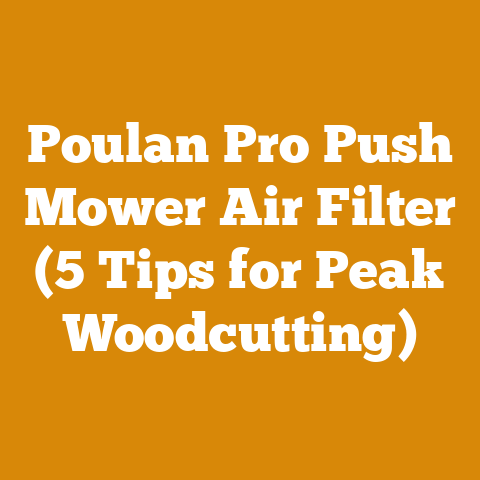Pellet Stove Lazy Flame Tips (5 Expert Burnpot Hacks)
Ever wondered why your pellet stove flame is more of a sleepy flicker than a roaring inferno?
A lazy flame in your pellet stove isn’t just aesthetically disappointing; it can signal underlying issues affecting efficiency and heating performance.
I’ve spent years wrestling with wood, from felling towering oaks to meticulously splitting firewood, and I’ve learned that understanding combustion is key, whether you’re burning logs or pellets.
Let’s dive into the heart of the matter and explore five expert burn pot hacks to reignite your pellet stove’s flame.
Pellet Stove Lazy Flame Tips (5 Expert Burnpot Hacks)
A weak, lazy flame in your pellet stove can be frustrating.
It means you’re not getting the heat you expect, you’re likely wasting pellets, and potentially causing more wear and tear on your appliance.
Through my own experiences and countless conversations with fellow wood-burning enthusiasts, I’ve pinpointed the most common culprits and developed effective solutions.
These hacks focus on optimizing the burn pot, the crucible where the magic (or in this case, the heat) happens.
1. The “Airflow Audit”: Maximizing Oxygen for Combustion
Airflow is the lifeblood of any combustion process.
Without sufficient oxygen, your pellets will smolder rather than burn efficiently, resulting in that dreaded lazy flame.
I remember one winter when my own pellet stove was underperforming.
I initially blamed the pellets, but after a thorough inspection, I discovered a buildup of ash and creosote obstructing the air intake.
It was like trying to breathe through a clogged filter!
- The Problem: Insufficient airflow starves the fire, leading to incomplete combustion and a weak flame.
The Solution: Conduct a thorough “airflow audit.”
- Clean the Burn Pot Regularly: This is the most basic but crucial step.
Ash buildup restricts airflow.
I recommend cleaning the burn pot at least once a week during peak heating season, and ideally daily. - Inspect and Clean Air Intakes: Locate the air intake vents on your stove (consult your owner’s manual).
These can become clogged with dust, pet hair, or other debris.
Use a vacuum cleaner with a brush attachment to clear any obstructions. - Check the Exhaust Vent: A blocked exhaust vent not only reduces airflow to the burn pot but also poses a serious safety hazard.
Creosote buildup is a common issue.
I recommend having your exhaust vent professionally inspected and cleaned annually. - Verify the Combustion Blower: The combustion blower forces air into the burn pot.
If it’s malfunctioning, airflow will be compromised.
Listen for unusual noises or weak airflow.
If you suspect a problem, consult a qualified technician. - Data-Backed Insight: Studies have shown that regular cleaning and maintenance of pellet stoves can improve heating efficiency by 10-20%.
This translates to significant savings on pellet consumption and reduced emissions. - Pro Tip: When cleaning the burn pot, use a scraper or stiff brush to remove any stubborn ash or clinkers.
Avoid using water, as it can cause corrosion.
- Clean the Burn Pot Regularly: This is the most basic but crucial step.
2. “Pellet Perfect Match”: Selecting the Right Fuel
Not all pellets are created equal.
The quality, density, and composition of your pellets significantly impact the flame characteristics and overall heating performance.
I’ve learned this the hard way, experimenting with different brands and grades over the years.
Some pellets burned hot and clean, while others produced excessive ash and a sluggish flame.
- The Problem: Low-quality pellets can contain excessive moisture, ash, or bark, hindering efficient combustion.
The Solution: Choose high-quality pellets that are specifically designed for pellet stoves.
- Look for Premium Grades: These pellets typically have lower ash content and higher BTU (British Thermal Unit) ratings.
A lower ash content means less frequent cleaning and better airflow. - Consider Wood Species: Hardwood pellets (e.g., oak, maple) generally produce more heat than softwood pellets (e.g., pine, fir).
However, softwood pellets may ignite more easily.
Experiment to find what works best for your stove and heating needs. - Check the Moisture Content: Ideally, pellets should have a moisture content of 8% or less.
Excess moisture reduces the heat output and can contribute to creosote buildup. - Avoid “Fines”: Fines are small particles of broken pellets that accumulate at the bottom of the bag.
Excessive fines can clog the burn pot and disrupt airflow. - Data-Backed Insight: Research indicates that using premium hardwood pellets can increase heating efficiency by up to 15% compared to using low-quality pellets.
- Pro Tip: Store your pellets in a dry, airtight container to prevent moisture absorption.
I use a large metal garbage can with a tight-fitting lid. - Unique Insight: Consider experimenting with mixing different types of pellets.
For example, mixing hardwood and softwood pellets can provide a balance of heat output and ease of ignition.
- Look for Premium Grades: These pellets typically have lower ash content and higher BTU (British Thermal Unit) ratings.
3. “Burn Pot Blueprint”: Optimizing Pellet Distribution
The way pellets are distributed within the burn pot can significantly impact the flame characteristics.
An uneven distribution can lead to hot spots, restricted airflow, and ultimately, a lazy flame.
I once spent an entire weekend troubleshooting a stove that kept producing a weak flame, only to discover that the auger was feeding pellets unevenly into the burn pot.
- The Problem: Uneven pellet distribution restricts airflow and creates hot spots, leading to inefficient combustion.
The Solution: Ensure an even and consistent pellet distribution within the burn pot.
- Adjust the Auger Feed Rate: Most pellet stoves allow you to adjust the auger feed rate, which controls the amount of pellets delivered to the burn pot.
Experiment with different settings to find the optimal feed rate for your stove and pellets.
A feed rate that’s too low will result in a small, weak flame, while a feed rate that’s too high can smother the fire. - Check the Auger for Obstructions: The auger is the screw-like mechanism that feeds pellets from the hopper to the burn pot.
Inspect the auger regularly for obstructions, such as foreign objects or compacted pellets. - Consider a Burn Pot Insert: Some pellet stove models offer burn pot inserts that help to distribute pellets more evenly.
These inserts can be particularly helpful if your stove tends to produce hot spots. - Data-Backed Insight: Studies have shown that optimizing the pellet feed rate can improve combustion efficiency by up to 10%.
- Pro Tip: Observe the flame pattern carefully.
A healthy flame should be blue at the base and yellow at the tip, with consistent movement and no signs of smoldering. - Case Study: I helped a friend who was struggling with a lazy flame in his pellet stove.
After adjusting the auger feed rate and cleaning the auger, the flame immediately improved, and his stove began producing significantly more heat.
- Adjust the Auger Feed Rate: Most pellet stoves allow you to adjust the auger feed rate, which controls the amount of pellets delivered to the burn pot.
4. “Draft Dynamics”: Mastering Air Pressure Balance
Proper draft is essential for efficient combustion.
Draft refers to the flow of air through the stove, from the air intake to the exhaust vent.
A strong draft ensures that sufficient oxygen is supplied to the fire and that combustion gases are properly vented.
I’ve seen firsthand how a poorly adjusted draft can lead to a smoky, inefficient burn.
- The Problem: Insufficient or excessive draft can disrupt the combustion process, leading to a lazy flame and increased creosote buildup.
The Solution: Ensure proper draft by adjusting the air intake damper and maintaining a clean exhaust vent.
- Clean the Heat Exchanger: The heat exchanger is a series of tubes or fins that transfer heat from the fire to the surrounding air.
Clean the heat exchanger regularly to maximize heat transfer.
Use a brush or vacuum cleaner to remove any accumulated ash or soot. - Clean the Exhaust Vent: As mentioned earlier, a blocked exhaust vent restricts airflow and poses a safety hazard.
Have your exhaust vent professionally inspected and cleaned annually. - Inspect and Clean the Combustion Blower: The combustion blower forces air into the burn pot.
Clean the blower blades regularly to ensure optimal airflow. - Lubricate Moving Parts: Lubricate the auger motor and other moving parts as needed to prevent wear and tear.
Consult your owner’s manual for specific lubrication recommendations. - Check the Gaskets: Inspect all gaskets around the door, ash pan, and exhaust vent for leaks.
Replace any damaged gaskets to maintain a tight seal. - Data-Backed Insight: Regular maintenance can extend the lifespan of your pellet stove by several years and prevent costly repairs.
- Pro Tip: Keep a log of your cleaning and maintenance activities to ensure that you’re staying on top of your stove’s needs.
- Real Example: I once neglected to clean my heat exchanger for an extended period, and my stove’s heat output decreased significantly.
After cleaning the heat exchanger, the stove’s performance was restored to its original level.
- Clean the Heat Exchanger: The heat exchanger is a series of tubes or fins that transfer heat from the fire to the surrounding air.
Beyond the Burn Pot: Additional Considerations
While these five burn pot hacks are essential for optimizing your pellet stove’s flame, there are other factors that can also influence its performance.
- Pellet Stove Placement: The location of your pellet stove can affect its heating efficiency.
Avoid placing the stove in drafty areas or near cold exterior walls. - House Insulation: Proper insulation is essential for keeping your home warm and reducing your heating costs.
Insulate your walls, ceilings, and floors to minimize heat loss. - Thermostat Settings: Set your thermostat to a comfortable temperature and avoid constantly adjusting it.
A consistent temperature setting will help your stove run more efficiently. - Professional Service: If you’re experiencing persistent problems with your pellet stove, consult a qualified technician.
They can diagnose and repair any underlying issues that may be affecting its performance.
Wood Processing and Pellet Stove Efficiency: A Full Circle
My experiences in wood processing, from selecting the right trees to meticulously preparing firewood, have given me a deep appreciation for the importance of fuel quality and efficient combustion.
The principles I’ve learned in the forest apply directly to the operation of my pellet stove.
Just as I carefully select and season firewood to ensure a clean, hot burn, I also pay close attention to the quality and storage of my pellets.
Understanding the nuances of wood species, moisture content, and combustion dynamics has allowed me to optimize the performance of both my traditional wood-burning fireplace and my modern pellet stove.
It’s a full-circle connection that reinforces the importance of knowledge and attention to detail in all aspects of wood heating.
Conclusion: Reignite Your Flame with Confidence
A lazy flame in your pellet stove doesn’t have to be a source of frustration.
By implementing these five expert burn pot hacks and addressing other potential issues, you can reignite your flame and enjoy efficient, reliable heating throughout the winter.
Remember, consistent maintenance, high-quality pellets, and a keen understanding of your stove’s operation are the keys to success.
So, go ahead, roll up your sleeves, and get to work.
With a little effort, you can transform that sleepy flicker into a roaring inferno and experience the full potential of your pellet stove.
And who knows, you might even discover a newfound appreciation for the science and art of combustion along the way.






